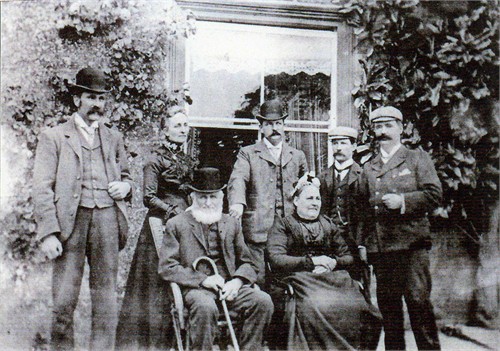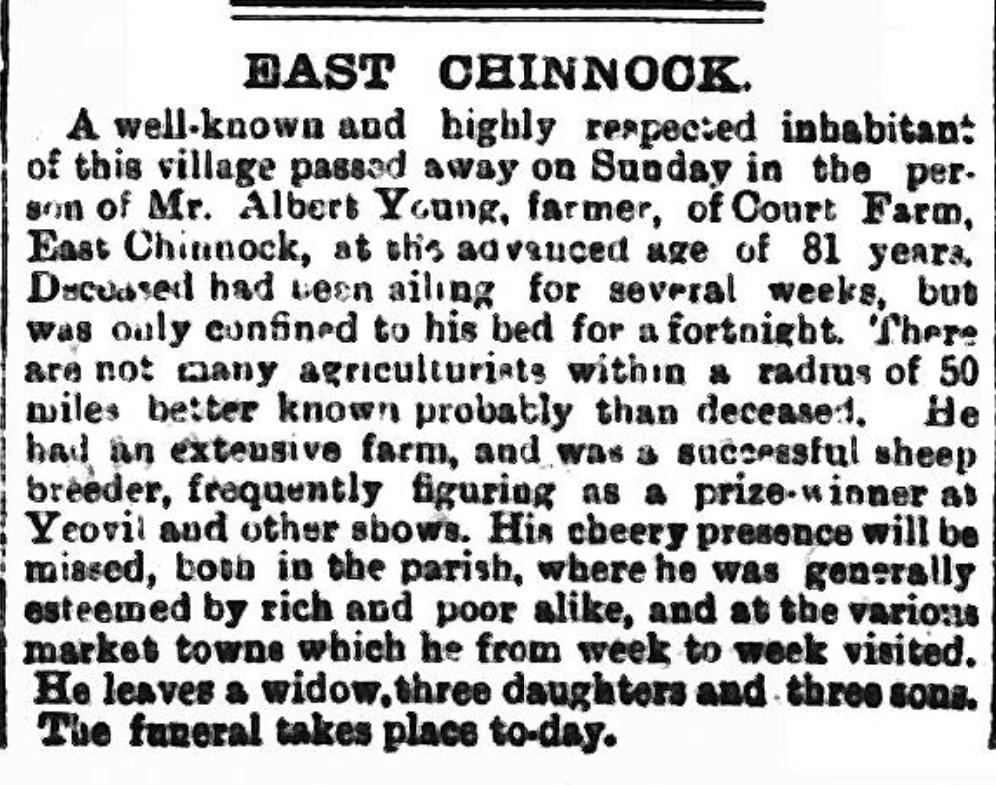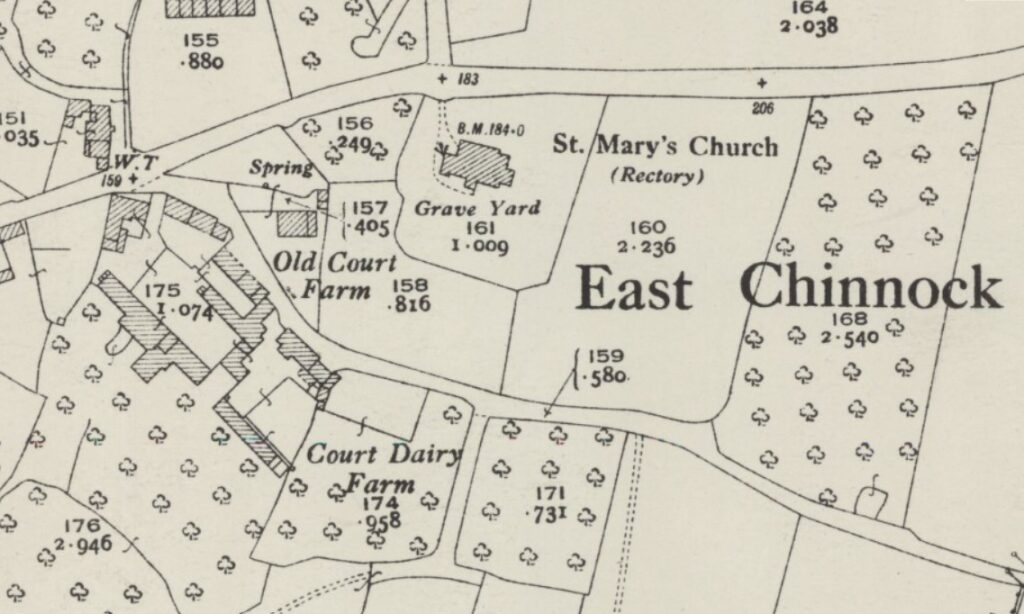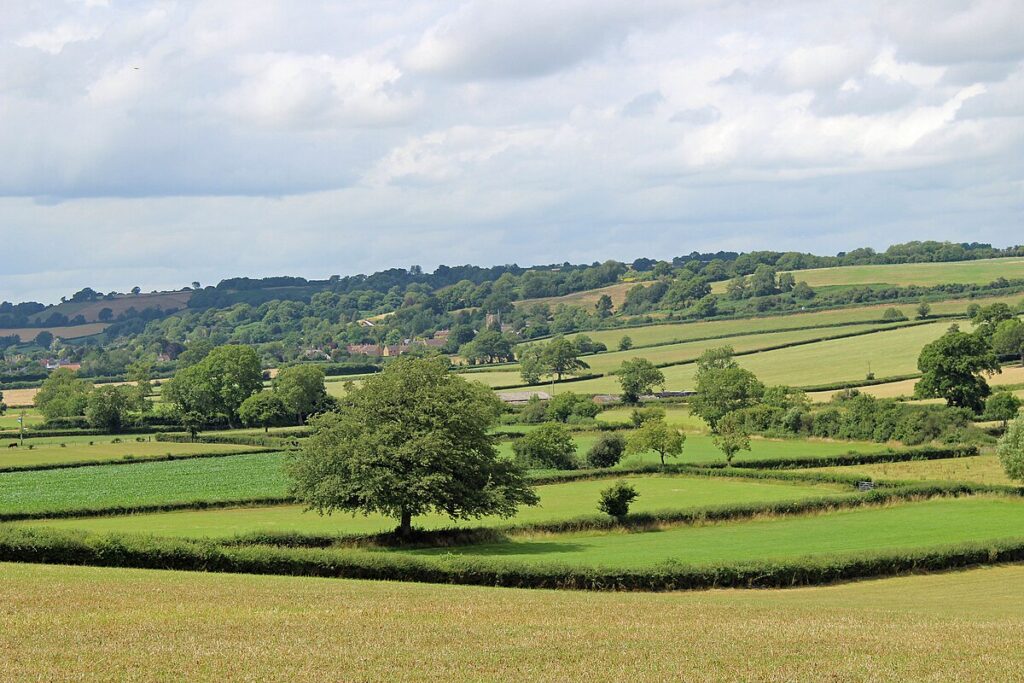Introduction
Albert Young was a prominent figure in the South Somerset farming community during the second half of the nineteenth century. Born at East Chinnock in 1820, he became the tenant of Manor Farm, Hardington, followed by a larger farm at East Chinnock. His cheerful disposition and contributions to farming and local governance earned him the respect of his neighbours and fellow parishioners.[1]
Birth
Albert, the second child of Samuel and Ann Young, was born at East Chinnock on 6 March 1820.[2]
Father’s death
His father, Samuel, a farmer, died on 23 January 1846, aged 54.[3] Three years later, his mother, Ann, married William Carter at Odcombe
Occupation
Albert began working as a farmer at a young age, initially for his father and then on his own farm.
Marriage
Albert married Susan Genge, the daughter of Abraham Genge, on 25 May 1849 at Hardington Church. This marriage elevated Albert’s social status, as Abraham was a substantial tenant farmer.
Albert and Susan may have been courting for at least two years, having witnessed the marriage of Susan’s sister, Elizabeth, to John Purchase at Bradford Abbas on 16 May 1847.
Children
Albert and Susan’s first child, Ann, was born at East Chinnock on 21 July 1850. Their other children—Samuel, Sarah, Jane, Susan, Albert, Elizabeth, William, Richard Ring, and Robert—were born at Hardington.
Manor Farm
By March 1851, Albert was the tenant of Manor Farm, Hardington. The 1851 census recorded him as a farmer of 118 acres, employing four labourers. In addition to his wife and daughter, his household included three servants: his sister, Harriet (27), George Trask (18), and Albert Voizey (15).
The 1861 census recorded Albert as a farmer occupying 202 acres, employing seven men and seven boys. At that time, his household at “New Manor Farmhouse” included his wife, their eight children, a nurse named Jane Groves (aged 53), and a dairymaid named Sarah Eastment (aged 16).
Parish offices
Albert served as an overseer in 1853 and a churchwarden from 1855 to 1859.[4]
Tenants’ dinners
During the 1840s and 1850s, Manor Farm was at the centre of an annual New Year’s Day event organised by the estate land agent, J W Peters, where forty to fifty farmers gathered for hare coursing, followed by a dinner. Albert Young and his wife hosted several dinners in the late 1850s.[5]
A prize-winning employee
On 13 October 1868, one of Albert’s employees, Henry Bartlett, won first prize in a hedging competition.[6]
Death of mother
After the death of her second husband in 1854, Albert’s mother moved to Hardington, where she lived when she made her will on 19 October 1860. She left a weekly sum of 4s to her daughter, Harriet, for life and the remainder to Albert. She died on 21 November 1867, at the age of 77, leaving an estate valued at “under £200.”[7] While it is doubtful that her estate was sufficient to support her daughter’s annuity, the matter was never tested as Harriet predeceased her, allowing Albert to inherit the whole amount.
East Chinnock
On 15 March 1870. Albert and Susan’s daughter, Ann, married Adam Thomas Rendell. Adam took over the tenancy of Manor Farm while Albert and his family relocated to East Chinnock.
The move benefitted Albert by giving him a larger acreage to farm with his sons. The 1871 census recorded him as a farmer of 461 acres, employing twenty men and nine boys. The 1881 census showed him farming 434 acres and employing sixteen men, one shepherd, eight boys, and two women. During his time at East Chinnock, he earned a reputation as a successful sheep breeder and often won prizes at Yeovil and other agricultural shows.[8]
At the time the 1871 census was taken, all ten children lived at the family home at 5 East Street, except for Ann. Their ages ranged from Samuel, 19, to Robert, 4. Over the following sixteen years, all but two of the remaining children either died or left home. The four daughters married local men; three married farmers, and one married a draper. In 1875, Samuel emigrated to Australia, where he died ten years later. By April 1881, Richard had left home and was living at Blandford. On 9 June 1887, he married Alice Mary Bartlett at Hastings and soon after emigrated to Australia. Later that same month, on 28 June, William died at his parent’s home from a disease of the spine at the age of 26.[9] By April 1891, Robert and Albert were the only children left at home, although Ann returned after the death of her sister Sarah in 1899.
The 1871 census recorded Albert’s youngest child, Robert, as a boarder at a school in East Street, Bridport, but it is unclear whether any of his siblings received an education outside of the village.
When he was 57, Albert came close to death while visiting Bath for an agricultural show. The incident occurred on 6 June 1877 as he crossed a pedestrian bridge over the Avon. The surrounding crowd became so dense that the bridge collapsed under its weight, plunging over a hundred people into the river. About a dozen people lost their lives, and many others were injured. Albert was lucky to escape with his life, and although he was taken to the hospital with contusions, he was discharged the following day.[10]
In January 1878, Albert and his son, Albert, junior, were trustees of the East Chinnock Charity, participating in an exchange of land with Viscount Portman.[11]
In 1886, Albert and Susan would have supported their daughter Ann when her husband suffered a mental breakdown that resulted in his long-term confinement in a private asylum near Salisbury.[12] They also took in Ann’s youngest son, Maurice William.[13]
During the 1890s, Albert and Susan faced heartbreak with the untimely deaths of their daughters, Elizabeth Marden and Sarah Penny. Sadly, Sarah was the fourth of their children to predecease them.
Death
Albert died on 26 January 1902 at the age of 81. His estate was valued at £5,665 4s 6d gross and £5,050-15s 11d net.
His funeral reflected his status and popularity, drawing people from across the district. The committee of the East Chinnock Friendly Society led the funeral procession from his home to the church, which included several of Albert’s employees, six of whom acted as bearers. Among the floral tributes was one shaped like an anchor, sent by 53 East Chinnock parishioners, along with a letter of condolence to Albert’s widow.[14]
Memorial
On 31 July 1902, a service was held at East Chinnock Church to celebrate the installation of a new stained-glass window in memory of Albert, who had served as a churchwarden for 28 years.[15]
The administration of Albert’s estate
On 31 July 1903, Albert’s trustees held a sale at the Three Choughs Hotel, Yeovil, to sell the Mason’s Arms Inn, Odcombe, along with its outbuildings and two acres, to finalise the closing of Albert’s estate.[16]
Susan’s later life
By April 1911, Susan lived at Court Farm with her sons, Albert and Robert, and her daughter, Ann. Susan died on 7 January 1921, aged 90.
Children
1850-Ann (married Adam Thomas Rendell, a farmer, in 1870; died intestate at East Chinnock on 25 May 1927, aged 76, leaving an estate valued at £116 1s 9d);
1851-Samuel (emigrated to Australia in 1875; died on 26 April 1885);
1853-Sarah (married Benjamin Samuel Dunn Penny, a draper, in 1876; died in 1899);
1854-Jane (married Edwin Down Marden, a farmer, in 1875; died in 1936);
1856-Susan (married Arthur Rendell, a farmer, in 1885; died in 1922);
1858-Albert (never married; he remained at Court Farm until he died in 1939);
1859-Elizabeth (married Walter Henry Marden, a farmer, in 1884; died in 1893);
1861-William (died of spinal disease in 1887);
1862-Richard Ring Young (married Alice Mary Bartlett, a farmer’s daughter, in 1887; emigrated to Australia in 1887; returned in about 1897; emigrated again in 1910; died in 1943);
1866-Robert (married Dora Edith Brake, a farmer’s daughter and his second cousin once removed, at Limington in 1911; they lived at Barrows Farm, East Chinnock, and their daughter, Lorna Mary, went on to marry John Frederick Booth, son of Bernard Booth of Gribble, Booth & Shepherd, auctioneers and estate agents).
The will of Albert Young
Executors and trustees: my sons, Albert and Robert, and my son-in-law, Benjamin Penny
To my wife, Susan: my household effects and £100.
To my sons Albert and Robert: my one-third share in the farming partnership of Court Farm, in East Chinnock, West Coker and Hardington Mandeville.
Income from residue to my wife for life and then:
To my granddaughter, Elsie Marden, £300 [she was the only child of the late Elizabeth Marden],
To the children of my deceased daughter, Sarah Penny, one-fifth of the residue,
To my children Ann Randall, Jane Marden, Susan Rendell, and Richard Ring Young, four-fifths of residue in equal shares.
References
[1] Western Chronicle, 31 January 1902, p.4.
[2] Young family Bible; Western Chronicle, 7 February 1902, p.8.
[3] Monumental inscription at East Chinnock; civil registration death index.
[4] Hardington Jury lists.
[5] Sherborne Mercury, 9 January 1855, p.2; 8 January 1856, p.3; 12 January 1858, p.6
[6] Western Gazette, 16 October 1868, p.5.
[7] The will of Harriet Carter, dated 19 October 1860, proved at the Principal Registry on 8 January 1868.
[8] Western Chronicle, 31 January 1902, p.4.
[9] Lunacy Patients Admission Registers, 1846-1921; death certificate.
[10] Western Daily Press, 8 June 1877, p.5.
[11] Western Gazette, 4 January 1876, p.1.
[12] Lunacy Patients Admission Registers, 1846-1921.
[13] 1891 census.
[14] Western Chronicle, 31 January 1902, p.4; 7 February 1902, p.8; Bridport News, 7 February 1902, p.6
[15] Western Chronicle, 1 August 1902, p.5.
[16] Western Gazette, 24 July 1903, p.1.





